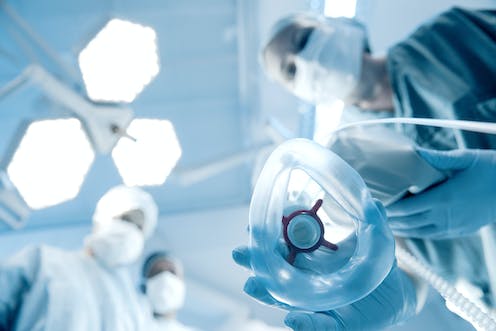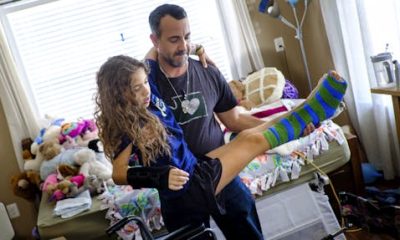
Having witnesses or recording devices during procedures requiring anesthesia could help prevent opportunities for sexual assault. Science Photo Library/Getty Images
Some patients can have vivid and detailed sexual hallucinations during anesthesia with sedative-hypnotic drugs like propofol, midazolam, diazepam and nitrous oxide. Some make suggestive or sexual comments or act out, such as grabbing or kissing medical professionals or touching themselves in a sexual way. Others awaken erroneously believing they were sexually assaulted. Why does this happen?
Doctors have long known that sedative-hypnotic drugs, which slow down brain activity to induce calm or sleep, can affect a patient’s perception of reality. A 1984 review of the drugs midazolam, ketamine and thiopental found that 18% of patients receiving anesthesia for a dental or medical procedure had a hard time distinguishing reality from fantasy during and shortly after administration. Similarly, a 1980 study found that around 14% of patients report some sexual dreaming or arousal while under anesthesia. It’s no surprise that together these two features of anesthesia could sometimes manifest in sexual hallucinations.
Propofol is a commonly used anesthetic.
There have been rare cases in which medical professionals used a patient’s unconscious state to commit sexual assault. For instance, in 1991, a health professional sexually assaulted a university student under anesthesia. Although the case was initially dismissed on the grounds that the patient could have had a drug-induced sexual hallucination, genetic evidence the health professional left behind later led to his conviction. It cannot be assumed that all cases of reported sexual assault under anesthesia are due to a sexual hallucination.
We are pharmacology researchers who recently reviewed the medical literature on sexual assault or sexual fantasy during anesthesia from the earliest documented case to February 2023, finding 87 reported cases from 17 published papers. Better understanding what triggers unpleasant or sexual dreams under anesthesia could help researchers figure out how to reduce the risk of hallucinations to keep both patients and providers safe.
Reports of sexual hallucinations
Sixteen of the individual cases we found in our review involved patients reporting sexually amorous behavior or perceived sexual assault. In these cases, observers like health professionals or family members were also present during the procedure, reducing the chance that the sexual behavior actually occurred versus being hallucinated.
We also found a striking match between the anatomic location of the procedure and where the patient perceived inappropriate sexual contact. Procedures involving the mouth were perceived as oral sex, squeezing a ball to make a vein more accessible as squeezing a penis, chest procedures as breast fondling and groin procedures as vaginal penetration.
This may explain why one assessment of 200 patients found no cases of sexual hallucination for those undergoing gallbladder or appendix procedures involving the abdomen, but around 12% of those undergoing vaginal procedures noted amorous or sexually disinhibited behavior.
Trauma for both patients and providers
These anesthesia effects can have major real-world impacts on patients and providers that last long after the surgery.
The emotional turmoil a patient undergoes is likely the same whether actually experiencing sexual assault under anesthesia or having vivid hallucinations of the event. And practitioners too can experience distress: Some medical professionals accused of real or perceived sexual assault have been brought before regulatory boards or the courts and lose their license to practice.
It is possible that if patients knew a hallucination of sexual assault is a rare but possible adverse effect of anesthesia before they receive it, and were aware of the steps medical providers are taking to reduce that risk, they would be less likely to believe their sexual hallucinations were real. But this would not lessen the trauma of the hallucination. In one case, an anesthesiology student volunteered in a study where she experienced sexual hallucination after taking sedative-hypnotics. Although she knew her vivid memories of the sexual assault weren’t real, the distress she felt over them led her to withdraw from the study.
An experience of sexual assault can lead to significant psychological trauma.
Portra Images/Stone via Getty Images
In our review of the literature, we found 71 individual cases in which the medical professional was alone with the patient at the time of the alleged sexual assault or sexual behavior. For the safety and well-being of both patients and medical professionals, having witnesses in the room or recording devices during dental or medical procedures could help prevent an opportunity for sexual assault and reassure patients that the hallucinations they may experience are not real.
However, the health care system needs to go further to protect patients. Patients struggling with the trauma of hallucinated sexual assault, even if there is evidence that it did not occur in reality, should be referred to counseling and supported just like someone who was physically harmed during a medical or dental procedure.
Many unknowns remain
What makes some people more likely to recall their dreams while under anesthesia is unclear. A 2009 study of 97 patients receiving propofol reported that those who frequently remember their dreams after anesthesia received higher doses of anesthetics, were younger than 50 years old and took longer to recover from anesthesia. A 2013 study of 200 patients receiving propofol found that men were more likely to remember dreams after anesthesia but women were more likely to remember unpleasant dreams. While dreaming and hallucinations are related experiences, people experiencing hallucinations believe they could plausibly be real.
While we reviewed all published cases of sexual hallucinations in the medical literature, the actual incidence of anesthesia-induced sexual hallucinations remains unknown. Given the decades that have passed since the first reported cases, more work needs to be done. Data from a very large sample size of patients will be required to understand the prevalence of sexual hallucinations under anesthesia. However, drug companies are reluctant to spend money on research that may show that their drugs cause adverse side effects.
A number of prescription sedative-hypnotic drugs can cause hallucinations.
Grace Cary/Moment via Getty Images
Finally, though we limited our review to reports of sexual hallucinations during anesthesia, millions of Americans use other prescription sedative-hypnotic drugs. Benzodiazepines like alprazolam (Xanax) and temazepam (Restoril) are used to treat anxiety and induce sleep. Z-drugs like zolpidem (Ambien) and eszopiclone (Lunesta) as well as suvorexant (Belsomra) and sodium oxybate (Xyrem) are also used to induce sleep. Opioids like morphine and oxycodone and gabapentinoids like gabapentin (Neurontin) and pregabalin (Lyrica) are used to treat pain. Muscle relaxers like carisoprodol (Soma) and cyclobenzaprine (Flexeril) are used for muscle spasms. All of these drugs have had reported cases of patients experiencing hallucinations while taking them.
In a review of the FDA Adverse Events Reporting System, which public health officials and researchers use to monitor drug safety, 30,728 cases of “abnormal dreaming” were reported from 1974 through 2022. Most involved sedative-hypnotic drugs treating insomnia, anxiety, pain and muscle spasms. The reports do not specify the nature of these dreams, or how they affected the patient’s own perceived well-being.
It is important for patients to be aware that abnormal dreaming is a possibility when starting a sedative-hypnotic medication, and to inform their health professional if they experience hallucinations. These symptoms could indicate that the drug is not the right choice for you or that the dose may be too high.
The authors do not work for, consult, own shares in or receive funding from any company or organization that would benefit from this article, and have disclosed no relevant affiliations beyond their academic appointment.
Advertisement

Advertisement
Contact Us
If you would like to place dofollow backlinks in our website or paid content reach out to info@qhubonews.com











